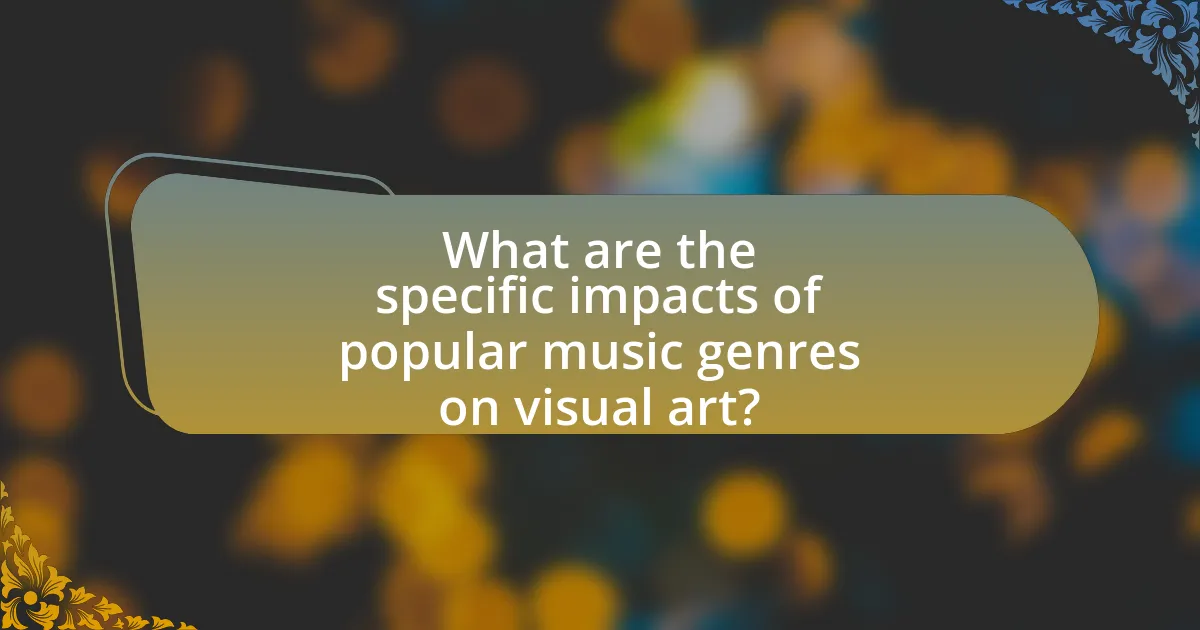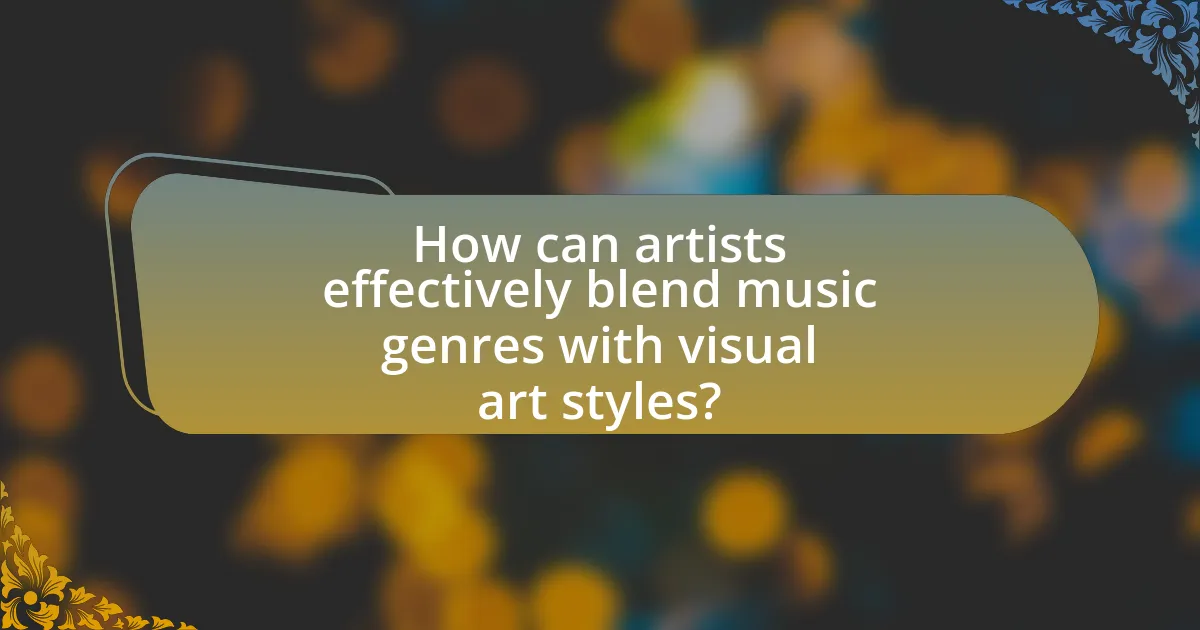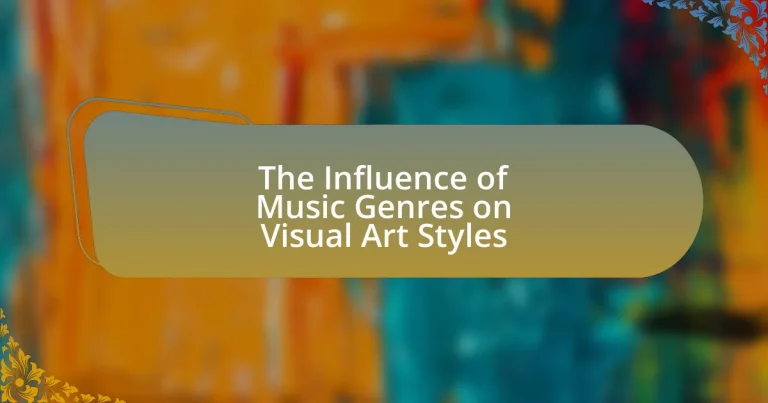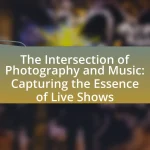The article examines the influence of music genres on visual art styles, highlighting how different musical forms shape themes, color palettes, and emotional expressions in art. It discusses specific examples, such as the impact of jazz on abstract art and the connection between punk rock and street art, illustrating how auditory experiences translate into visual representations. Additionally, the article explores the characteristics of various music genres, their historical contexts, and the significance of studying the relationship between music and visual art, emphasizing the collaborative potential and cultural movements that arise from this interplay. Techniques for artists to blend these two forms of expression are also outlined, along with resources available for further exploration.

What is the Influence of Music Genres on Visual Art Styles?
Music genres significantly influence visual art styles by shaping themes, color palettes, and emotional expressions. For instance, the vibrant colors and abstract forms in the works of artists like Wassily Kandinsky were inspired by the rhythms and dynamics of jazz music, reflecting the improvisational nature of the genre. Similarly, the punk rock movement influenced street art and graffiti, characterized by bold colors and rebellious imagery, as seen in the works of artists like Banksy. These connections illustrate how the auditory experience of music can translate into visual representation, creating a dialogue between the two art forms.
How do different music genres shape visual art styles?
Different music genres significantly shape visual art styles by influencing themes, color palettes, and overall aesthetics. For instance, the vibrant and energetic nature of pop music often translates into bright colors and dynamic compositions in visual art, as seen in the works of artists like Andy Warhol, who drew inspiration from pop culture and music. In contrast, the raw and emotive qualities of punk music are reflected in the gritty, rebellious styles of street art and graffiti, exemplified by artists such as Banksy. Additionally, genres like jazz have inspired abstract art movements, where improvisation and fluidity in music correlate with spontaneous brushwork and forms in visual art, as demonstrated by artists like Jackson Pollock. These connections illustrate how the characteristics of various music genres directly inform and shape the visual expressions found in art.
What are the key characteristics of various music genres?
Various music genres possess distinct characteristics that define their sound, structure, and cultural significance. For example, rock music is characterized by strong beats, electric guitars, and a focus on live performance, often reflecting themes of rebellion and youth culture. In contrast, classical music emphasizes orchestration, complex compositions, and a wide range of dynamics, often associated with formal settings and historical traditions. Hip-hop features rhythmic vocal delivery, sampling, and a strong connection to urban culture, often addressing social issues. Jazz is known for its improvisation, syncopation, and swing feel, showcasing individual musicianship and creativity. Each genre’s characteristics influence not only the music itself but also its impact on visual art styles, as artists often draw inspiration from the themes and emotions conveyed in the music.
How do these characteristics translate into visual art?
Characteristics of music genres translate into visual art through the use of color, form, and composition that reflect the emotional and thematic elements of the music. For instance, the vibrant colors and dynamic shapes in abstract expressionism often mirror the intensity and improvisational nature of jazz music. Similarly, the structured patterns and symmetry found in classical music can be represented in visual art through geometric designs and balanced compositions. Historical examples include Wassily Kandinsky, whose works were influenced by the rhythms and tones of music, demonstrating a direct correlation between auditory and visual experiences.
Why is it important to study the relationship between music and visual art?
Studying the relationship between music and visual art is important because it reveals how these two forms of expression influence and enhance each other. Research indicates that both music and visual art share common elements such as rhythm, harmony, and emotion, which can lead to a deeper understanding of cultural and historical contexts. For example, the Abstract Expressionist movement in the 1940s and 1950s was heavily influenced by jazz music, as artists like Jackson Pollock sought to capture the spontaneity and energy of jazz in their work. This interplay not only enriches artistic practices but also fosters interdisciplinary collaboration, allowing for innovative approaches in both fields.
What historical contexts highlight this relationship?
The historical contexts that highlight the relationship between music genres and visual art styles include the emergence of the avant-garde movements in the early 20th century, particularly in Europe. During this period, artists like Wassily Kandinsky and Piet Mondrian were influenced by the rhythms and structures of contemporary music, leading to the development of abstract art that mirrored musical compositions. For instance, Kandinsky’s work was directly inspired by the symphonic qualities of music, which he believed could evoke emotions similar to visual art. Additionally, the Harlem Renaissance in the 1920s showcased the interplay between jazz music and visual arts, as artists like Aaron Douglas incorporated jazz’s dynamic rhythms into their visual narratives, reflecting the cultural significance of the genre. These contexts illustrate how music genres have historically shaped visual art styles, creating a dialogue between auditory and visual experiences.
How does this influence cultural movements in art?
Music genres significantly influence cultural movements in art by shaping aesthetic values and thematic expressions. For instance, the emergence of jazz in the early 20th century inspired artists like Jean-Michel Basquiat and Jackson Pollock, who incorporated improvisational techniques and vibrant colors reflective of jazz’s spontaneity. Similarly, the punk rock movement in the 1970s led to a raw, rebellious visual style in art, as seen in the works of artists like Jamie Reid, who used collage and graphic design to convey anti-establishment sentiments. These examples illustrate how music genres not only inspire visual styles but also serve as catalysts for broader cultural shifts within the art community.

What are the specific impacts of popular music genres on visual art?
Popular music genres significantly influence visual art by shaping aesthetic styles, themes, and cultural narratives. For instance, the vibrant colors and abstract forms in psychedelic art emerged from the counterculture movement of the 1960s, closely associated with rock music. Similarly, hip-hop culture has inspired street art and graffiti, reflecting urban life and social issues, as seen in the works of artists like Jean-Michel Basquiat. Additionally, the visual identity of pop music, exemplified by artists like Andy Warhol, has led to the incorporation of commercial techniques and imagery in visual art, blurring the lines between high art and popular culture. These examples illustrate how music genres not only inspire visual artists but also contribute to the evolution of art movements.
How does rock music influence visual art styles?
Rock music influences visual art styles primarily through its themes, aesthetics, and cultural movements. The vibrant and rebellious nature of rock music has inspired artists to adopt bold colors, dynamic compositions, and iconography that reflect the genre’s energy and ethos. For instance, the psychedelic rock movement of the 1960s led to the emergence of vivid, surreal artwork, as seen in the album covers of bands like The Beatles and Pink Floyd, which utilized intricate patterns and bright colors to evoke the hallucinogenic experiences associated with the music. Additionally, the punk rock movement in the 1970s influenced visual art through its DIY ethos and anti-establishment imagery, leading to the creation of raw, graphic styles that challenged traditional artistic norms. This connection between rock music and visual art is evident in the works of artists like Andy Warhol, who famously collaborated with rock bands, further solidifying the interplay between these two creative domains.
What visual elements are commonly associated with rock music?
Visual elements commonly associated with rock music include bold colors, dynamic imagery, and iconic symbols such as guitars and skulls. These elements reflect the energetic and rebellious nature of the genre, often utilizing dark tones and contrasting colors to evoke emotion. For instance, album covers from bands like Led Zeppelin and The Rolling Stones frequently feature striking graphics that capture the essence of rock culture. Additionally, the use of typography in promotional materials often incorporates edgy fonts that resonate with the genre’s attitude. This visual language has been influential in shaping the aesthetic of rock music and its associated art styles.
How have iconic rock album covers shaped visual art trends?
Iconic rock album covers have significantly shaped visual art trends by introducing innovative design elements and challenging conventional aesthetics. For instance, the cover of Pink Floyd’s “The Dark Side of the Moon” (1973) utilized a prism to symbolize the spectrum of light, influencing graphic design and color theory in visual arts. Similarly, The Beatles’ “Sgt. Pepper’s Lonely Hearts Club Band” (1967) showcased a collage style that inspired contemporary artists to explore mixed media and surrealism. These album covers not only served as marketing tools but also became cultural artifacts that reflected and influenced the artistic movements of their time, such as pop art and psychedelic art. The impact of these designs is evident in the works of artists like Andy Warhol and Robert Rauschenberg, who incorporated similar visual strategies into their art, demonstrating the profound connection between music and visual art trends.
What role does hip-hop play in the evolution of visual art?
Hip-hop plays a significant role in the evolution of visual art by serving as a catalyst for new styles and forms of expression. The genre has influenced street art, graffiti, and contemporary art movements, leading to the emergence of vibrant visual aesthetics that reflect hip-hop culture. For instance, artists like Jean-Michel Basquiat and Keith Haring incorporated elements of hip-hop into their work, blending music, social commentary, and visual storytelling. Additionally, the rise of hip-hop has fostered collaborations between musicians and visual artists, further blurring the lines between these disciplines and promoting a dynamic exchange of ideas. This interplay has resulted in a rich tapestry of visual art that continues to evolve alongside hip-hop, showcasing its impact on cultural and artistic landscapes.
How does hip-hop culture influence street art and graffiti?
Hip-hop culture significantly influences street art and graffiti by providing a platform for self-expression, identity, and social commentary. The origins of graffiti are closely tied to hip-hop’s emergence in the 1970s, where artists used public spaces to convey messages and assert their presence, paralleling the lyrical storytelling found in hip-hop music. For instance, the use of vibrant colors, bold lettering, and intricate designs in graffiti often reflects the themes of hip-hop, such as resilience, community, and resistance against oppression. Additionally, iconic figures in hip-hop, like Jean-Michel Basquiat and Keith Haring, have blurred the lines between street art and mainstream art, further legitimizing graffiti as a vital form of artistic expression. This connection is evident in the way graffiti artists often draw inspiration from hip-hop lyrics and culture, creating works that resonate with the same audiences that consume hip-hop music.
What are the visual themes prevalent in hip-hop-inspired art?
Hip-hop-inspired art prominently features themes of urban culture, social commentary, and self-expression. These themes are often depicted through vibrant colors, graffiti styles, and imagery that reflects the realities of street life, identity, and resistance. For instance, artists like Jean-Michel Basquiat and Keith Haring incorporated elements of hip-hop culture into their works, using bold lines and dynamic compositions to convey messages about race, inequality, and empowerment. The prevalence of these themes is supported by the rise of street art as a legitimate art form, with exhibitions and galleries increasingly showcasing works that draw from hip-hop influences, highlighting its significance in contemporary visual culture.

How can artists effectively blend music genres with visual art styles?
Artists can effectively blend music genres with visual art styles by utilizing thematic elements and emotional resonance inherent in both forms. For instance, a visual artist can draw inspiration from the rhythm and mood of jazz music to create dynamic, fluid compositions that reflect the improvisational nature of the genre. This approach is supported by the historical collaboration between musicians and visual artists, such as the works of Wassily Kandinsky, who was influenced by the music of his time, demonstrating that visual art can embody the essence of sound. Additionally, artists can experiment with multimedia installations that incorporate soundscapes, allowing viewers to experience the interplay between auditory and visual stimuli, further enhancing the fusion of these art forms.
What techniques can artists use to incorporate musical elements into their artwork?
Artists can incorporate musical elements into their artwork through techniques such as synesthesia, rhythm visualization, and the use of sound-based materials. Synesthesia allows artists to translate auditory experiences into visual forms, creating pieces that evoke the sensations of music through color and shape. Rhythm visualization involves representing musical beats and patterns visually, often through repetitive motifs or dynamic compositions that mimic the flow of music. Additionally, artists can use sound-based materials, such as incorporating actual musical instruments or sound recordings into their work, to create a multisensory experience that engages viewers both visually and aurally. These techniques demonstrate the interplay between music and visual art, highlighting how sound can influence artistic expression.
How can rhythm and tempo be represented visually?
Rhythm and tempo can be represented visually through various methods such as graphical notation, visual art, and multimedia installations. Graphical notation uses symbols and shapes to depict musical elements, allowing viewers to interpret rhythm and tempo visually. For example, the use of varying line lengths and thickness can indicate different tempos, while patterns and repetitions can represent rhythmic structures. Additionally, visual art inspired by music genres often incorporates elements that reflect the tempo and rhythm of the music, such as dynamic brush strokes in abstract paintings that mimic the energy of fast-paced music. Multimedia installations can also combine visual elements with sound, creating an immersive experience where rhythm and tempo are represented through synchronized visual patterns and movements. These methods provide concrete ways to visualize the auditory experience of rhythm and tempo, enhancing the understanding of their influence on visual art styles.
What are some examples of successful collaborations between musicians and visual artists?
Successful collaborations between musicians and visual artists include the partnership between David Bowie and artist Brian Duffy, who created iconic album covers such as “Aladdin Sane.” Another notable example is the collaboration between the band Gorillaz and artist Jamie Hewlett, which resulted in a unique animated band aesthetic that complements their music. Additionally, the collaboration between musician Pharrell Williams and artist Takashi Murakami for the album “Girl” showcases a fusion of pop culture and visual art. These collaborations demonstrate how visual artists can enhance the musical experience through compelling imagery, creating a cohesive artistic identity that resonates with audiences.
What best practices should artists follow when exploring this fusion?
Artists exploring the fusion of music genres and visual art styles should prioritize collaboration and experimentation. Collaboration with musicians can provide insights into the emotional and thematic elements of music, which can enhance visual storytelling. Experimentation with different mediums and techniques allows artists to discover unique ways to express the interplay between sound and sight.
Additionally, artists should study the historical context of both music and visual art to understand how they have influenced each other over time. For instance, the relationship between jazz and abstract expressionism illustrates how rhythm and improvisation can inspire visual forms. Engaging with diverse musical genres can also broaden an artist’s perspective, leading to innovative artistic expressions that resonate with a wider audience.
How can artists ensure their work resonates with both music and art audiences?
Artists can ensure their work resonates with both music and art audiences by integrating elements from both disciplines into their creations. This can be achieved through the use of visual motifs that reflect musical themes, such as rhythm, harmony, and emotion, which are prevalent in various music genres. For instance, artists can draw inspiration from the color palettes and forms associated with specific music styles, like the vibrant colors of jazz or the stark contrasts found in punk rock art. Research indicates that cross-disciplinary collaborations, such as those seen in multimedia installations, enhance audience engagement by appealing to diverse sensory experiences. By actively participating in music-related events or exhibitions, artists can also create a dialogue between their visual art and the music community, fostering a deeper connection with both audiences.
What resources are available for artists looking to explore this intersection?
Artists exploring the intersection of music genres and visual art styles can access various resources, including interdisciplinary workshops, online courses, and collaborative projects. For instance, organizations like the Creative Capital offer funding and professional development opportunities specifically for artists working at this intersection. Additionally, platforms such as Skillshare and Coursera provide courses on visual art influenced by music, allowing artists to learn techniques and concepts that merge these two fields. Furthermore, art collectives and music festivals often host events that encourage collaboration between musicians and visual artists, fostering an environment for creative exploration. These resources collectively support artists in understanding and expressing the dynamic relationship between music and visual art.


